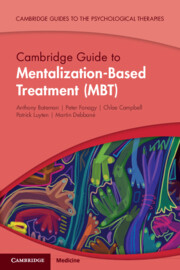Book contents
- Cambridge Guide to Mentalization-Based Treatment (MBT)
- Cambridge Guides to the Psychological Therapies
- Reviews
- Cambridge Guide to Mentalization-Based Treatment (MBT)
- Copyright page
- Contents
- Preface
- A Note from the Series Editor
- Acknowledgments
- Part I Overview of the Model
- Part II The Mentalization-Based Treatment Model in Practice
- Part III Application and Adaptations for Mental Health Presentations
- Part IV Application of Mentalization-Based Treatment in Different Populations and in Different Settings
- Chapter 13 Working with Children
- Chapter 14 Working with Adolescents
- Chapter 15 Working with Families
- Chapter 16 Working with Couples
- Chapter 17 Mentalizing in Other Settings
- Chapter 18 Mentalizing and Emergency Care
- Index
- References
Chapter 14 - Working with Adolescents
from Part IV - Application of Mentalization-Based Treatment in Different Populations and in Different Settings
Published online by Cambridge University Press: 18 May 2023
- Cambridge Guide to Mentalization-Based Treatment (MBT)
- Cambridge Guides to the Psychological Therapies
- Reviews
- Cambridge Guide to Mentalization-Based Treatment (MBT)
- Copyright page
- Contents
- Preface
- A Note from the Series Editor
- Acknowledgments
- Part I Overview of the Model
- Part II The Mentalization-Based Treatment Model in Practice
- Part III Application and Adaptations for Mental Health Presentations
- Part IV Application of Mentalization-Based Treatment in Different Populations and in Different Settings
- Chapter 13 Working with Children
- Chapter 14 Working with Adolescents
- Chapter 15 Working with Families
- Chapter 16 Working with Couples
- Chapter 17 Mentalizing in Other Settings
- Chapter 18 Mentalizing and Emergency Care
- Index
- References
Summary
Social mentalizing informs the theory and practice of mentalization-based treatment for adolescents (MBT-A). Adolescence is, among other things, a time for establishing a self-identity and learning about how to interact effectively with a peer group. A focus on balancing mentalizing in peer and family interactions is crucial, with special attention to hypermentalizing and the alien self. Involvement of families and schools in treatment is necessary. MBT-A includes individual, family, and group therapy, and its overall aim is to develop the patient’s independence. Crucial aspects of achieving this goal include building up relational stability and supporting the patient’s sense of agency and autonomy within their relational networks.
Keywords
- Type
- Chapter
- Information
- Cambridge Guide to Mentalization-Based Treatment (MBT) , pp. 328 - 339Publisher: Cambridge University PressPrint publication year: 2023



